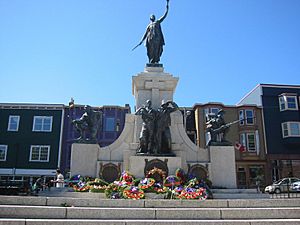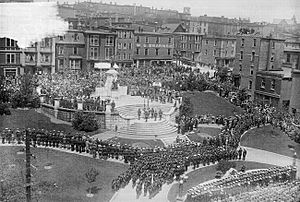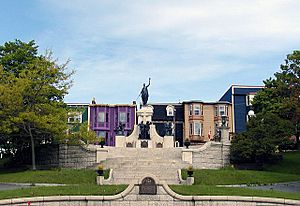National War Memorial (Newfoundland) facts for kids
Quick facts for kids National War Memorial |
|
|---|---|
 |
|
| For soldiers of Newfoundland, World War I | |
| Unveiled | July 1, 1924 |
| Location | 47°34′03.28″N 52°42′13.67″W / 47.5675778°N 52.7037972°W near St. John's, Newfoundland, Canada
|
| Designed by | Father Thomas Nangle |
|
Erected by "a grateful people to honour its war dead"
|
|
The National War Memorial in Downtown St. John's is a very important monument in Newfoundland and Labrador. It was built to remember the brave people from Newfoundland who served in World War I. This memorial stands on Water Street at King's Beach. This spot is special because in 1583, Sir Humphrey Gilbert claimed Newfoundland for England right here.
The memorial was officially shown to the public on Memorial Day, July 1, 1924. A famous military leader, Field Marshal Douglas Haig, 1st Earl Haig, was there for the unveiling. Groups like the Great War Veterans' Association and the Newfoundland Patriotic Association worked hard to make this memorial happen. They formed a committee to plan its look and raise money for it. Lieutenant-Colonel Father Thomas Nangle, a Roman Catholic priest from the Royal Newfoundland Regiment, helped supervise the building. Captain Gerald (Gerry) Whitty also helped.
Contents
Understanding the Memorial's Design
The National War Memorial has a special design. It is shaped like a half-circle. The ground gently rises from the entrance on Water Street up to the main monument, called a cenotaph, on Duckworth Street. Five bronze figures are part of the memorial. Two English sculptors, Ferdinand Victor Blundstone and Gilbert Bayes, created these figures. They were made in London, England, by E.J. Parlanti. These figures show how Newfoundland was involved in World War I.
Symbolic Figures and Their Meanings
At the very top of the central part of the memorial is a figure of a woman. She represents Newfoundland's willingness to help and its loyalty to the Empire. In her left hand, she holds a flaming torch, which stands for freedom. In her right hand, she holds a sword, ready for battle if needed.
Two granite "wings" stick out from the sides of the central part. On the west side, there is a sailor holding a spyglass. This figure represents the Newfoundlanders who joined the Newfoundland Royal Naval Reserve, serving at sea. On the east side, there is a soldier in full battle gear, loading his rifle and looking for the enemy. This figure represents the brave men of the Royal Newfoundland Regiment.
In front of the memorial, on a lower stone base, are figures of fishermen wearing oilskins and Wellington boots. There is also a lumberman with his axe. These figures represent the Newfoundlanders who served in the Merchant Marine (who sailed ships) and the Forestry Corps (who worked in forests). Above these figures is a granite cross, showing the sacred importance of the memorial. Below them, a bronze plaque says the memorial was built by "a grateful people to honour its war dead". Other plaques were added later to remember Newfoundlanders who died in World War II, the Korean War, and the War in Afghanistan.
Annual Remembrance Ceremonies
Every year, important ceremonies are held at the National War Memorial. These events remember the service members who died in past wars.
- April 25: This day remembers the Gallipoli offensive during World War I.
- First Sunday in May: The Battle of the Atlantic is remembered on this day.
- July 1: This is Memorial Day, which remembers the Battle of the Somme at Beaumont-Hamel.
- Third Sunday in September: The anniversary of the Battle of Britain is celebrated.
- November 11: This is Armistice Day, which marks the official end of World War I.
Memorial's Lasting Impact
In 1928, Newfoundland released a postage stamp called 'War Memorial, St. John's'. The design of this stamp was based on the sculptures found on the memorial. These stamps were printed by Thomas De La Rue & Company.
Images for kids




